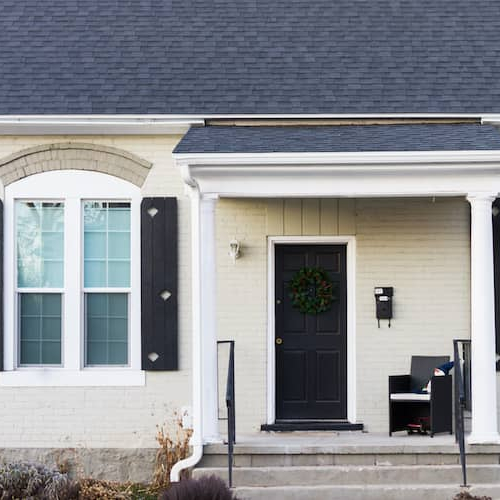VA loan entitlement: Everything you need to know
Jan 9, 2025
•8-minute read
Understanding your VA loan entitlement and the role it plays in the home buying process can be challenging. However, with a little guided research, you’ll be able to identify key concepts such as how much VA loan you qualify for and how to calculate this number.
Once you start shopping around for a mortgage, it’s important to understand the amount you can borrow to purchase a home. If you’re eligible for a VA loan, your certificate of eligibility (COE) will state the size of your entitlement.
Let’s carefully explore the basics of VA loan entitlements, the different types of VA loan entitlement, and how to calculate your VA entitlement amount if you’re VA entitlement-eligible.
What is VA entitlement?
VA entitlement is the amount the Department of Veterans Affairs (VA) will guarantee on a borrower’s VA loan. In other words, it’s the maximum amount the VA will repay your lender if you default on your loan.
One of the great benefits of getting a VA loan and certain other non-conforming loans is that you don’t need to make a down payment. Your VA entitlement amount indicates the maximum amount you can borrow without making a down payment.
Full entitlement
You should have full entitlement if you’ve never taken out a VA loan or you paid off a previous VA loan and sold the property the loan was used to purchase.
When you have full entitlement, none of your entitlement is tied up in another property and your full entitlement is available to purchase a home.
There’s no limit on how much you can borrow without needing to make a down payment. The VA will guarantee up to 25% of the loan amount – even if it exceeds the conforming loan limit in your county or the county where you want to buy a home.
However, that doesn’t mean you can borrow an unlimited amount of money; you can only borrow as much as a lender qualifies you for. Your lender will look at your income, credit score, debts and credit history to determine how much they’ll let you borrow.
Reduced entitlement
If your entitlement amount is reduced, technically, there’s no limit on how much you can borrow to purchase a home. But if your loan amount exceeds your total entitlement amount (basic entitlement plus bonus entitlement), you have to make a down payment.
You may have partial entitlement if you’re currently paying back a VA loan, you defaulted on a previous VA loan, or you’ve repaid your loan but still own the home you purchased with the loan and you haven’t received your one-time entitlement restoration.
If your entitlement is reduced, the VA will only guarantee up to 25% of the county’s conforming loan limit – minus the amount of your entitlement you’ve already used.
Certificate of eligibility (COE) and VA entitlement codes
A certificate of eligibility (COE) is a document proving an active-duty service member, veteran, surviving spouse, or someone who’s served in the National Guard or Army Reserve meets the military service requirements to apply for a VA home loan. The COE also contains information about the entitlement amount.
Your COE will have an entitlement code listed on it. Most entitlement codes correspond with specific wartime or peacetime periods and indicate how you earned your entitlement.
If you don’t have a COE, your lender can typically obtain this for you once you start the mortgage application process. You can also apply for your COE online through the VA’s eBenefits site.
Types of VA loan entitlement
Your COE will tell you how much you have in “basic” entitlement. However, you’ll also likely have an additional entitlement – sometimes called your bonus or Tier 2 entitlement.
The ideas of basic entitlement and bonus entitlement can get a little confusing, but borrowers generally won’t have to worry about these terms.
Here’s a short breakdown of the two types of entitlement and how they work.
VA loan basic entitlement
If you have full entitlement, your COE will say, “This veteran’s basic entitlement is $36,000.”
It’s important to note that the $36,000 isn’t a limit on how much you can borrow or how much the VA will guarantee. For loans under $144,000, the VA will guarantee 25% of the loan amount up to $36,000.
That doesn’t mean you’re limited to loans up to $144,000. Once you’ve used up your basic entitlement, your bonus entitlement kicks in.
VA loan bonus entitlement
Bonus entitlement is available for loans over $144,000. If you have full entitlement, the VA will guarantee up to 25% of your loan amount.
If your COE states that your entitlement is $0, it doesn’t mean you’re loan ineligible; it just means that your entire $36,000 basic entitlement is currently being used. You may still have bonus entitlement available.
To figure out how much bonus entitlement you have after using your full basic entitlement, you’ll have to do a little bit of math. Let’s see how to calculate this.
Calculating your VA entitlement amount
You don’t have a loan limit if you have full entitlement, so you don’t need to worry about calculating how much entitlement you have. You can borrow as much money as a lender is willing to lend, with no down payment.
If you have reduced entitlement and want to know how much you have left, you’ll need to figure out how much entitlement you’re currently using.
Remember that the VA guarantees up to 25% of your loan. To find out how much of your entitlement you’ve used, simply multiply your loan amount by 0.25.
VA loan entitlement formula
This is how the formula would look for calculating your entitlement:
Loan Amount × 0.25 = Entitlement You’ve Used
You’ll also need to determine your county’s conforming loan limit. In 2025, the standard VA loan limit with reduced entitlement is $806,500 for a one-unit home. Higher-cost areas have limits determined on a county-by-county basis. In the highest-cost areas, the loan limit is as high as $1,209,750. It’s also higher than the standard limit for a one-unit home if you’re buying more than one unit.
How do you calculate the maximum loan amount with partial entitlement?
The maximum entitlement is equal to 25% of the conforming loan limit for your county.
County Conforming Loan Limit × 0.25 = Maximum Entitlement
However, if you have a reduced entitlement, you likely won’t be able to borrow up to the maximum without a down payment. You can determine your remaining entitlement by subtracting the entitlement you’ve already used from the maximum entitlement amount.
Maximum Entitlement - Entitlement You’ve Used = Remaining Entitlement
Your remaining entitlement is the maximum amount the VA will guarantee on your loan. Since the VA guarantees 25% of the loan, you can multiply your remaining entitlement by 4 to see the maximum amount you can borrow without making a down payment.
Remaining Entitlement × 4 = Maximum Loan Amount With Zero Down
VA loan entitlement example
Let’s say you used a VA loan to purchase your current home for $300,000 with no down payment. You’ve just received permanent change of station orders. Now suppose you plan to buy a home at your new assignment but can’t sell your current home and have your VA loan entitlement restored. This means you’ll end up buying your new home with your remaining entitlement.
Step 1: Determine How Much Entitlement You’ve Used
The amount of entitlement you’ve already used is equal to 25% of the loan amount. In this scenario, you’ve already used $75,000 of your entitlement.
$300,000 × 0.25 = $75,000
Step 2: Calculate The Maximum VA Guarantee Amount
The conforming loan limit in your new location is the standard limit: $806,500. This helps you calculate the maximum VA loan guarantee in an impacted entitlement scenario:
$806,500 × 0.25 = $201,625
Step 3: Find Your Remaining Entitlement
To find out the amount of your remaining entitlement, you’ll need to subtract the amount you’ve already used from your county loan maximum.
$201,625 - $75,000 = $126,625
Step 4: Multiply Your Remaining Entitlement
To find out the total amount you can borrow with no down payment, multiply $126,625 by 4.
$126,625 × 4 = $506,500
You could potentially get a loan of up to $506,500 without having to make a down payment.
You may be able to take out a larger loan, but you’ll likely need to make a down payment to make up the difference between the amount you want to borrow and the maximum amount your entitlement covers.
If your new loan is for $550,000, the VA won’t guarantee that additional $43,500 ($550,000 - $506,500 = $43,500). Most lenders want to be guaranteed at least 25% of the loan amount, so you’ll have to make up the difference between what the VA covers and this 25% guarantee if you have reduced entitlement. This would be your down payment.
How do you restore your VA home loan entitlement?
If you’ve previously taken out a VA loan, you can have your entitlement fully restored by paying back the loan and selling the property attached to the loan. You may also qualify for a one-time entitlement restoration if you’ve paid back your loan but haven’t sold the property attached to the loan. (You would’ve paid back your loan by reaching the end of the loan term or refinancing to a different loan type, such as a conventional mortgage loan.)
If you don’t have full entitlement and don’t qualify for a one-time restoration, you can figure out how much remaining entitlement you have by using the formulas discussed above.
Essentially, you can’t use entitlement that’s already tied up in a loan, but once your entitlement has been restored – typically by repaying your loan and selling your home – you’re free to reuse your full entitlement benefit.
VA loan entitlement FAQs
Next are answers to a few frequently asked questions about VA loan entitlement.
What’s the difference between entitlement versus guaranty?
The VA doesn’t lend VA loans directly. Private lenders originate VA loans, and the VA agrees to guarantee a portion of each loan a lender originates. This arrangement is sometimes referred to as a guaranty.
Your entitlement is the amount the VA will guarantee on your loan. If you default on your loan, the VA will repay your lender up to this amount.
Does VA loan entitlement provide cash to the borrower?
Because a VA loan is a type of government-insured loan, a VA loan entitlement won’t give you cash. Since the federal government backs the loan, the borrowed money can only go toward the home – not for any other purposes.
Is VA loan entitlement a lifetime benefit?
If you qualify for a VA loan, you can use your entitlement as many times as you’d like. However, if you want a zero-down payment mortgage, you’ll need your basic, bonus or combined entitlement available to cover the loan’s cost.
The bottom line: Entitlement helps you understand how much you can borrow with zero down
Your VA loan entitlement amount tells you how much of your loan the VA will guarantee.
No matter how much entitlement you have available, you’ll only be able to borrow as much as a lender is willing to offer. Plus, you should ensure you’re getting a loan you can comfortably afford for your budget.
Ready to start the home buying process? You can apply for a mortgage online with Rocket Mortgage®.

Miranda Crace
Miranda Crace is a Senior Section Editor for the Rocket Companies, bringing a wealth of knowledge about mortgages, personal finance, real estate, and personal loans for over 10 years. Miranda is dedicated to advancing financial literacy and empowering individuals to achieve their financial and homeownership goals. She graduated from Wayne State University where she studied PR Writing, Film Production, and Film Editing. Her creative talents shine through her contributions to the popular video series "Home Lore" and "The Red Desk," which were nominated for the prestigious Shorty Awards. In her spare time, Miranda enjoys traveling, actively engages in the entrepreneurial community, and savors a perfectly brewed cup of coffee.
Related resources
4-minute read
VA funding fee: What to expect
The VA funding fee is a one-time charge you pay to help fund the VA loan program and protect your lender and the VA from financial losses if you default. Learn ...
Read more

8-minute read
Buying a second home with a VA loan
VA loans are designed to help military personnel, veterans, and their families buy a primary residence, but there are ways you can use one to buy a second home.
Read more

6-minute read
How many times can you use a VA loan?
There’s no limit to the number of VA loans qualified borrowers can take out, but you usually can’t hold multiple VA loans at once. Let’s break...
Read more